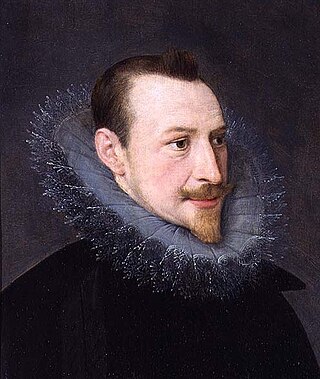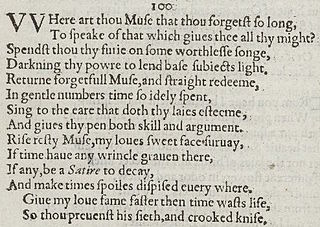In poetry, a couplet is a pair of successive lines that rhyme and have the same metre. A couplet may be formal (closed) or run-on (open). In a formal (closed) couplet, each of the two lines is end-stopped, implying that there is a grammatical pause at the end of a line of verse. In a run-on (open) couplet, the meaning of the first line continues to the second.

Edmund Spenser was an English poet best known for The Faerie Queene, an epic poem and fantastical allegory celebrating the Tudor dynasty and Elizabeth I. He is recognized as one of the premier craftsmen of nascent Modern English verse, and he is considered one of the great poets in the English language.

Elizabethan literature refers to bodies of work produced during the reign of Queen Elizabeth I (1558–1603), and is one of the most splendid ages of English literature. In addition to drama and the theatre, it saw a flowering of poetry, with new forms like the sonnet, the Spenserian stanza, and dramatic blank verse, as well as prose, including historical chronicles, pamphlets, and the first English novels. Major writers include William Shakespeare, Edmund Spenser, Christopher Marlowe, Richard Hooker, Ben Jonson, Philip Sidney and Thomas Kyd.

Sonnet 3 is one of 154 sonnets written by the English playwright and poet William Shakespeare. It is often referred to as a procreation sonnet that falls within the Fair Youth sequence.

Sonnet 8 is one of 154 sonnets written by the English playwright and poet William Shakespeare. It is a procreation sonnet within the Fair Youth sequence. As with the other procreation sonnets, it urges a young man to settle down with a wife and to have children. It insists a family is the key to living a harmonious, peaceful life.

Sonnet 153 is a sonnet by William Shakespeare.

Sonnet 10 is one of 154 sonnets written by the English playwright and poet William Shakespeare. It is a procreation sonnet within the Fair Youth sequence.

Sonnet 15 is one of 154 sonnets written by the English playwright and poet William Shakespeare. It forms a diptych with Sonnet 16, as Sonnet 16 starts with "But...", and is thus fully part of the procreation sonnets, even though it does not contain an encouragement to procreate. The sonnet is within the Fair Youth sequence.

Sonnet 19 is one of 154 sonnets published by the English playwright and poet William Shakespeare in 1609. It is considered by some to be the final sonnet of the initial procreation sequence. The sonnet addresses time directly, as it allows time its great power to destroy all things in nature, but the poem forbids time to erode the young man's fair appearance. The poem casts time in the role of a poet holding an “antique pen”. The theme is redemption, through poetry, of time's inevitable decay. Though there is compunction in the implication that the young man himself will not survive time's effects, because redemption brought by the granting of everlasting youth is not actual, but rather ideal or poetic.
Nationality words link to articles with information on the nation's poetry or literature.

Sonnet 49 is one of 154 sonnets written by the English playwright and poet William Shakespeare. It is a member of the Fair Youth sequence, in which the poet expresses his love towards a young man.

Sonnet 61 is one of 154 sonnets written by the English playwright and poet William Shakespeare. It is a member of the Fair Youth sequence, in which the poet expresses his love towards a young man.

Sonnet 100 is one of 154 sonnets written by the English playwright and poet William Shakespeare. It is a member of the Fair Youth sequence, in which the poet expresses his love towards a young man.

Sonnet 63 is one of 154 sonnets published in 1609 by the English playwright and poet William Shakespeare. It is one of the Fair Youth sequence. Contrary to most of the other poems in the Fair Youth sequence, in Sonnets 63 to 68 there is no explicit addressee, and the second person pronoun is not used anywhere in sonnets 63 to 68.

Sonnet 150 is one of 154 sonnets written by the English playwright and poet William Shakespeare. It is considered a Dark Lady sonnet, as are all from 127 to 152. Nonetheless 150 is an outlier, and in some ways appears to belong more to the Fair Youth.
Sonnet 149 is one of 154 sonnets written by the English playwright and poet William Shakespeare.

Sonnet 148 is one of 154 sonnets written by the English playwright and poet William Shakespeare.

Sonnet 142 is one of 154 sonnets written by the English playwright and poet William Shakespeare.

Sonnet 82 is one of 154 sonnets published by William Shakespeare in a quarto titled Shakespeare's Sonnets in 1609. It is a part of the Fair Youth series of sonnets, and the fifth sonnet of the Rival Poet group.

Sonnet 104 is one of 154 sonnets written by the English playwright and poet William Shakespeare. It is a member of the Fair Youth sequence, in which the poet expresses his love towards a young man.
This page is based on this
Wikipedia article Text is available under the
CC BY-SA 4.0 license; additional terms may apply.
Images, videos and audio are available under their respective licenses.

















